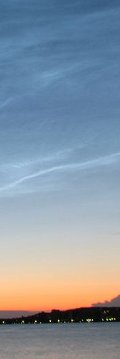| |
| |
Photographer,
Location |
Images |
Comments |
|

|
Peter
Rosén,
Stockholm - Sweden
Jul. 13, 2008 |
#1 |
The
Noctilucent Clouds have not been very prominent this year
here in Stockholm but they do appear almost every night
close to the northern horizon. This is a panorama of 2 pictures
taken shortly before midnight and exposed for 13 seconds
at f/5.6.
Photo
details: Canon
Eos 40D and a 70-200/2.8 zoom. |
|

|
Tunç
Tezel,
near Bolu, Turkey
Jul. 13, 2008 |
#1 |
This
view of NLC can be one of the farthest from pole. I went
to mile-high Tasliyayla Plateau, 40 km south of Bolu, Turkey
for dark skies. Noctilucent clouds lit up as soon as the
morning twilight started. Amazing... For the record, my
location was 40d 31' N, 31d 37' E.
Photo
details: Canon
EOS 5D camera at ISO 50, 35 mm lens at f/4, 20-second
exposure. |
|

[movie]
|
Jan
Lameer,
Schermer Polder, 30 km north of Amsterdam, Netherlands (53N
4E)
Jul. 13, 2008 |
#1,
#2, movie,
more |
The
noctilucent clouds were allready visible 80 minutes after
sunset, usually we see them only in the latter part of the
night. It seemed that there were two "origins" for the cloud
waves, roughly ten degrees apart horizontally.
Photo
details: Nikon
D1H with 24 and 200 mm lenses, exposures of 2 seconds
per frame each at 400 ISO setting. |
|

|
P-M
Hedén,
Vallentuna, Sweden
Jul. 12, 2008 |
#1,
#2, #3,
#4, more |
At
last some stronger Noctilucent Clouds here in Sweden. There
has been some very few a weak NLC displays lately and I
hope that it will be better days to come.
Photo
details: 20mm Sigma, 50mm Canon and a Canon
450D. |
|

|
Marja
Wallin,
Vesijärvi, Lahti, Finland
Jul. 13, 2008 |
#1,
#2, more |
Heard
in the stormchasers irc-channel that noctilucent clouds
were appearing in the eastern sky. Quick check from the
balcony and I left with a friend to the lake shore to see
the northern view. They really were quite bright and beautiful
and I got my first noctilucent cloud photos ever. |
|

|
David
Roles,
Edmonton, Alberta, Canada
Jul. 9, 2008 |
#1,
#2, #3,
more |
Noctilucent
clouds seem more prevalent in northern Europe than North
America this year. Nevertheless, we have had some good sightings
in Edmonton, Canada. The first photo was taken in the early
morning hours of June 28, the next photo was taken several
days later and the last photo was taken about 1:00 am yesterday
on the 9th of July. |
more
images (July 10): from
David of Saint Martin du Mont, Bourgogne, France; from
Lukas Ronge of Pec pod Snezkou, Czech Republic; from
Artur Grodz of Stralsund, Mecklenburg-Vorpommern, Germany;
from
Alan C Tough on the North Sea (56 deg 40' N, 4 deg 04' E);
from
Oleg Pomogaev of Moscow, Russia
more
images (July 13): from
Henrik and Emma Herranen of Tampere, Finland, Europe; from
Ed Valenti of Newport Pagnell, UK; from
Richard Fleet of Pewsey Vale, Wiltshire, England; from
Jan Tromp of Beverwijk, Netherlands; from
Philippe Mollet- MIRA Public Observatory of Grimbergen, close
to Brussels (Belgium); from
Jeff Zambory of Calgary, Alberta, Canada; from
Raymond Westheim of Oss, The Netherlands; from
Edwin van Schijndel of Oss, The Netherlands
more
images (July 14): from
Bert Berends of Apeldoorn The Netherlands; from
Martijn Harleman of Wilp and Deventer, The Netherlands
|
|







